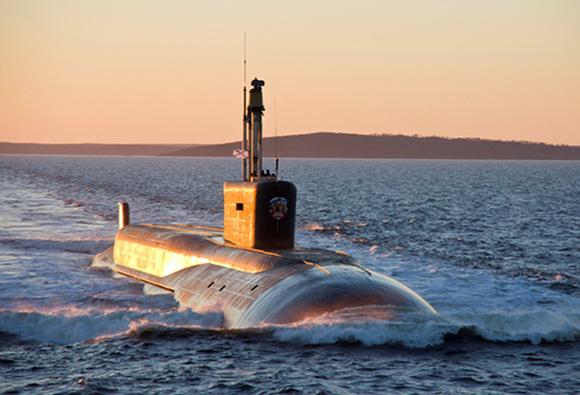The last nuclear-powered submarine class Borei, the Knyaz Pozharsky, will go into production in just a week, at the Sevmash shipyard, in Severodvinsk. The fourth-generation class submarines Borei will involve the backbone of the strategic nuclear deterrent of the Russian Navy. They will replace the class submarines Typhoon, Delta-3 e Delta-4.
The first three Borei Project 955, I am the K-535 Yury Dolgoruky who joined the Northern Fleet in January of the 2013, followed by the K-550 Aleksandr Nevskij at the end of December of the same year. The Nevsky is in service with the Pacific Fleet. The K-551Vladimir Monomakh (opening photo) entered service in the 2014. Submarines Yuri Dolgoruky e Vladimir Monomakh they were assigned to the permanent alert force with patrol missions in the Arctic and the globe. Fourth Borei, the Knyaz Vladimir, first in the 955 / A Project, 2012 has been under construction since July at the Sevmash shipyard in northern Russia. The construction of the fifth nuclear-powered submarine Knyaz Oleg began in July of the 2014. Work on Generalissimus Suvorov they started in December last year. A few weeks later, even the seventh Borei, baptized Imperator Aleksandr III, entered production at the Severodvinsk construction site. The yard for the last class submarine Borei and fifth in the A series, the Prince Pozharsky, the next December 23 will be launched.
Within the 2020, the Russian Navy plans to operate on a total of eight class ballistic submarines Borei: three 955 and five 955-A or Borei II.
Designed on a hydrodynamic hull designed to reduce noise from broadband, the class Borei it is the first in the Russian navy to use propulsion pump-jet.
Submarines Borei they are long 170 meters, with a diameter of 13 meters and a maximum immersion speed of 46 kilometers per hour conferred by the OK-650 nuclear reactor. The operational depth is attested on the 380 meters (maximum test occurred at 450 meters).
Each Borei should carry sixteen to twenty missiles Bulava (only for 955A), each of which has from six to ten Mirv titles. The three-stage missile Bulava, codename Nato SS-N-30 Mace, is the naval version of the most advanced Russian ballistic missile, the SS-27 Topol-M. It can also be launched in motion. It is 12,1 meters long, 2,1 meter diameter and heavy 36,8 tons: it can hit targets up to eight thousand kilometers away and is designed to exclusively equip class nuclear submarines Borei (changes on Typhoon were deemed too expensive).
Last July, the Academician VPMakeyev State Rocket Center received a government contract for the design and development of a new ballistic missile. For the first time, reference is made to the missile substitute Bulava, not yet entered service, but plagued by numerous development problems. The new missiles could equip both fourth-generation ballistic class submarines Borei than those of fifth grade Husky.
Despite tests on new intercontinental missiles Bulava, the Russian Ministry of Defense has not yet declared them operational. The possible coverage of sensitive targets, considering the range of eight thousand kilometers, could be the Barents Sea and the Sea of Okhotsk.
The first Borei, the K-535 Yury Dolgoruky, it cost the Russian government 720 millions of dollars, including research and development chapters.
Class submarines Husky
 The fifth-generation class submarines Husky should enter service by the middle of the 2035. Although the class specifications Husky are covered by military secrecy, we know that they will support the class attack submarines Yasen (photo on the right), although they will be built in a larger number than the 885m Project. The Husky will be made in two versions, both based on the same hull. The main difference will be determined by the main weapon system delivered. The Husky-A will replace the class Akula, Sierra e Victor III. The Husky-B, SSGN variant, will replace the class Antey, 949A project. The SSGN variant could be the first in the world equipped as standard equipment with hypersonic cruise missiles Zircon.
The fifth-generation class submarines Husky should enter service by the middle of the 2035. Although the class specifications Husky are covered by military secrecy, we know that they will support the class attack submarines Yasen (photo on the right), although they will be built in a larger number than the 885m Project. The Husky will be made in two versions, both based on the same hull. The main difference will be determined by the main weapon system delivered. The Husky-A will replace the class Akula, Sierra e Victor III. The Husky-B, SSGN variant, will replace the class Antey, 949A project. The SSGN variant could be the first in the world equipped as standard equipment with hypersonic cruise missiles Zircon.
the class Husky it will be much smaller, there is talk of a displacement of 6 thousand tons, and less expensive than the class Yasen. According to some rumors, the Husky could implement a certain degree of automation, with some of the systems already tested in the 705 class project Lira. Moscow could have succeeded in optimizing the liquid metal reactor technology (the class Lira used the lead-bismuth to cool the reactors). If so, the designers would be able to overcome the typical criticalities that reveal such a system. Specifically, a liquid metal reactor generates more energy and is much more compact than pressurized water. However, liquid metal requires a constant optimum temperature and external support structures for oxide removal.
- Husky could introduce the massive use of composite materials, already tested in the Yasen class, in an attempt to drastically reduce their acoustic signatures. Again, we only have rumors.
We know that Moscow continues to invest tremendous resources in experimenting with new multilayer composite materials, which can reduce the acoustic signature, isolate vibrations or absorb them. The Russians are convinced of being able to use the new composite materials to make every part of them Husky, including hulls.
The first sea test with the new composite material will take place within the 2018.












